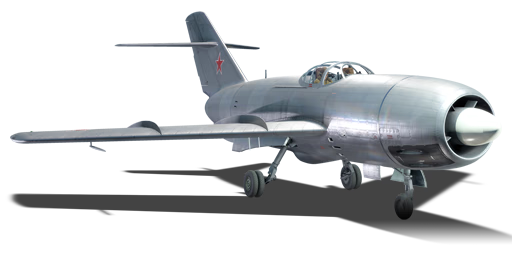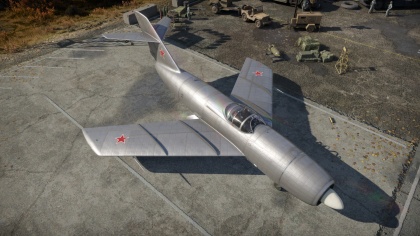La-200
Contents
Description
The La-200 is a rank Russian jet fighter
with a battle rating of (AB), (RB), and (SB). It was introduced in Update 1.77 "Advancing Storm". It is last aircraft in the "Lavochkin end" of the research tree.
General info
Flight Performance
Describe how the aircraft behaves in the air. Speed, manoeuvrability, acceleration and allowable loads - these are the most important characteristics of the vehicle.
| Characteristics | Max Speed (km/h at 0 m - sea level) |
Max altitude (metres) |
Turn time (seconds) |
Rate of climb (metres/second) |
Take-off run (metres) | |||
|---|---|---|---|---|---|---|---|---|
| AB | RB | AB | RB | AB | RB | |||
| Stock | 1,088 | 1,061 | 26.5 | 27.8 | 37.0 | 37.0 | 700 | |
| Upgraded | 1,110 | 1,101 | 25.6 | 26.0 | 58.7 | 47.0 | ||
Details
| Features | |||||
|---|---|---|---|---|---|
| Combat flaps | Take-off flaps | Landing flaps | Air brakes | Arrestor gear | Drogue chute |
| ✓ | ✓ | ✓ | ✓ | X | X |
| Limits | ||||||
|---|---|---|---|---|---|---|
| Wings (km/h) | Gear (km/h) | Flaps (km/h) | Max Static G | |||
| Combat | Take-off | Landing | + | - | ||
| 650 | 650 | 450 | ~12 | ~6 | ||
| Optimal velocities (km/h) | |||
|---|---|---|---|
| Ailerons | Rudder | Elevators | Radiator |
| < 600 | < 700 | < 750 | N/A |
Engine performance
| Engine | Aircraft mass | |||||
|---|---|---|---|---|---|---|
| Engine name | Number | Empty mass | Wing loading (full fuel) | |||
| Klimov VK-1 | 2 | 7,700 kg | 257 kg/m2 | |||
| Engine characteristics | Mass with fuel (no weapons load) | Max Takeoff Weight | ||||
| Weight (each) | Type | 9m fuel | 20m fuel | 31m fuel | ||
| 892 kg | Centrifugal-flow turbojet | 8,456 kg | 9,363 kg | 10,269 kg | 12,500 kg | |
| Maximum engine thrust @ 0 m (RB / SB) | Thrust to weight ratio @ 0 m (112%) | |||||
| Condition | 100% (front / rear) | WEP | 9m fuel | 20m fuel | 31m fuel | MTOW |
| Stationary | 2,430 / 2,520 kgf | N/A | 0.59 | 0.53 | 0.48 | 0.40 |
| Optimal | 2,430 / 2,520 kgf (0 km/h) |
N/A | 0.59 | 0.53 | 0.48 | 0.40 |
Survivability and armour
Examine the survivability of the aircraft. Note how vulnerable the structure is and how secure the pilot is, whether the fuel tanks are armoured, etc. Describe the armour, if there is any, and also mention the vulnerability of other critical aircraft systems.
Armaments
Offensive armament
Describe the offensive armament of the aircraft, if any. Describe how effective the cannons and machine guns are in a battle, and also what belts or drums are better to use. If there is no offensive weaponry, delete this subsection.
Usage in battles
Speed is your greatest advantage. The La-200 can outrun every jet at its BR and even some 9.0 jets. At the beginning of a match try to gather speed as soon as possible. In an 8.0 game, if you accelerate up to about 1000km/h noone will catch you even if they dive on you. You can use your speed to zoom climb and surprise any climbing (or AFK-ing) players. Remember that other fighters will be more maneuverable and that you can't afford taking any hits (top speed drops horribly if you get hit). Always make sure that you have enough energy to run away from the enemy if you miss. And you will miss a lot, the 37mm cannons are hard to lead and quite inaccurate, so I wouldn't recommend using them on long distances. They are, however, extremely effective when they hit (one shot is almost always enough) so it's possible to get many kills without landing.
Radars
The La-200 is equipped with a Toriy search radar, located in the radome in the centre of the air intake.
| Toriy - Target Detection Radar | |||
|---|---|---|---|
| Maximum Detection Range |
Guaranteed Detection Range |
Max Azimuth Scan Angle |
Max Elevation Scan Angle |
| 15,000 m | 12,000 m | ±30° | ±32° |
Manual Engine Control
| MEC elements | ||||||
|---|---|---|---|---|---|---|
| Mixer | Pitch | Radiator | Supercharger | Turbocharger | ||
| Oil | Water | Type | ||||
| Not controllable | Not controllable | Not controllable | Not controllable | Separate | Not controllable | Not controllable |
Modules
| Tier | Flight performance | Survivability | Weaponry | ||
|---|---|---|---|---|---|
| I | Fuselage Repair | Compressor | Offensive 37 mm | ||
| II | New boosters | Airframe | |||
| III | Wings Repair | New 37 mm cannons | |||
| IV | Engine | Cover | |||
Pros and cons
Pros:
- Extremely high top speed, can outrun everything at its rank and enter supersonic in a dive
- Good acceleration up to 800km/h
- Decent climbrate, great zoom climb capability
- Hard-hitting guns with decent rate of fire
- Second pilot takes over if the first one is knocked out
- Effective airbrake
- Has access to a target detection radar with decent range
Cons:
- Acceleration rate drops significantly above 800 km/h
- Horrible low speed performance
- Top speed drops dreadfully in case of any hull damage
- Elevator locks up at high speeds, can lead to a crash if you're not careful
- Guns are innacurate, hard to lead, and have relatively low ammo count (50 shells for each gun, 150 total)
- Huge target with no armour
- Bad cockpit visibility
- No payload
- Very high landing speed (>240km/h), hard to land even with no damage
- Not very useful when uptiered where its greatest advantage, top speed, is taken away
History
In 1948, Soviet high command issued a requirement for a two man, all-weather, twin -engined jet interceptor that would be capable of carrying a new type of radar system called “Toriy” (Thorium). All three Soviet design bureaus (Lavochkin, MiG, and Sukhoi) developed a prototype for testing.
Lavochkin’s design, the La-200, had a long fuselage to accommodate its two turbojet engines, swept wings, and a large cockpit for two men. The La-200 took its maiden flight on September 9th, 1949. It was the only aircraft of the three designs to pass initial trials.
By the early 1950s, the La-200 was ready to enter production under the official designation La-17. However, due to the appearance of the Yak-120 (later known as Yak-25), which surpassed the La-200’s performance in testing, the La-200 order was cancelled in favor of the Yakovlev design.
Only a single prototype of the La-200 was ever built, and it was modified several times during development to improve performance, correct flaws, and test other radar systems.
- From Devblog
Media
See also
Links to the articles on the War Thunder Wiki that you think will be useful for the reader, for example:
- reference to the series of the aircraft;
- links to approximate analogues of other nations and research trees.
External links
| Lavochkin Design Bureau (Лавочкинa Опытное конструкторское бюро) | |
|---|---|
| LaGG-3* | I-301 · LaGG-3-4 · LaGG-3-8 · LaGG-3-11 · LaGG-3-23 · LaGG-3-34 · LaGG-3-35 · LaGG-3-66 |
| La-5/7 | La-5 · La-5F · La-5FN · La-7 · Dolgushin's La-7 · La-7B-20 |
| La-9/11 | La-9 · La-11 |
| Jet Fighters | La-15 · La-174 · La-200 |
| Export | ␗La-9 · ␗La-11 |
| Captured | ▀La-5FN |
| *Lavochkin-Gorbunov-Gudkov (Лавочкин-Горбунов-Гудков), head designer V. P. Gorbunov | |
| USSR jet aircraft | |
|---|---|
| Bereznyak-Isayev | BI |
| Yakovlev | Yak-15 · Yak-15P · Yak-17 · Yak-23 · Yak-28B · Yak-30D · Yak-38 · Yak-38M · Yak-141 |
| Mikoyan-Gurevich | MiG-9 · MiG-9 (l) · MiG-15 · MiG-15bis · MiG-15bis ISh · MiG-17 · MiG-17AS · MiG-19PT |
| MiG-21F-13 · MiG-21PFM · MiG-21S (R-13-300) · MiG-21SMT · MiG-21bis | |
| MiG-23M · MiG-23ML · MiG-23MLD · MiG-27M · MiG-27K | |
| MiG-29 · MiG-29SMT | |
| Lavochkin | La-174 · La-15 · La-200 |
| Sukhoi | Su-9 · Su-11 |
| Su-7B · Su-7BKL · Su-7BMK · Su-17M2 · Su-17M4 · Su-22M3 | |
| Su-24M | |
| Su-25 · Su-25BM · Su-25K · Su-25T · Su-25SM3 · Su-39 | |
| Su-27 · Su-27SM | |
| Su-34 | |
| Ilyushin | IL-28 · IL-28Sh |
| Tupolev | Tu-14T |





